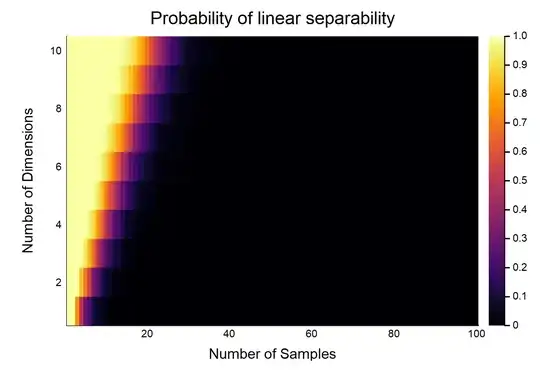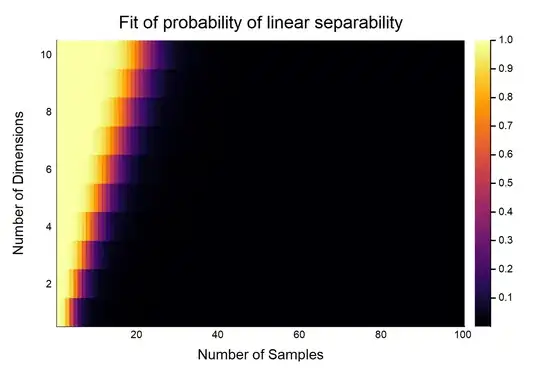Assuming no duplicates exist in the data.
If $n\leq d+1$, the probability is $\text{Pr}=1$.
For other combinations of $(n,d)$, see the following plot:

I generated this plot simulating input and output data as specified in the OP. Linear separability was defined as failure of convergence in a logistic regression model, due to the Hauck-Donner effect.
We can see the probability decreases for increasing $n$. In fact, we could fit a model relating $n, d$ to $p$, and this was the result:
$$P(n,d)={
1
\over
{1 + e^
{-(5.82944-4.58261\times n + 1.37271 \times d -0.0235785 \times n \times d)}
}
}$$

Code for the plot (in Julia):
using GLM
ds = 10; #number of dimensions to be investigated
ns = 100 #number of examples to be investigated
niter = 1000; #number of iterations per d per n
P = niter * ones(Int64, ds, ns); #starting the number of successes
for d in 1:ds
for n in (d+1):ns
p = 0 #0 hits
for i in 1:niter
println("Dimensions: $d; Samples: $n; Iteration: $i;")
try #we will try to catch errors in the logistic glm, these are due to perfect separability
X = hcat(rand((n,d)), ones(n)); #sampling from uniform plus intercept
Y = sample(0:1, n) #sampling a binary outcome
glm(X, Y, Binomial(), LogitLink())
catch
p = p+1 #if we catch an error, increase the count
end
end
P[d,n] = p
end
end
using Plots
gui(heatmap(P./niter, xlabel = "Number of Samples", ylabel = "Number of Dimensions", title = "Probability of linear separability"))
Code for the model relating $(n,d)$ to $p$ (in Julia):
probs = P./niter
N = transpose(repmat(1:ns, 1, ds))
D = repmat(1:ds, 1, ns)
fit = glm(hcat(log.(N[:]), D[:], N[:].*D[:], ones(ds*ns)), probs[:], Binomial(), LogitLink())
coef(fit)
#4-element Array{Float64,1}:
# -4.58261
# 1.37271
# -0.0235785
# 5.82944
gui(heatmap(reshape(predict(fit), ds, ns), xlabel = "Number of Samples", ylabel = "Number of Dimensions", title = "Fit of probability of linear separability"))

